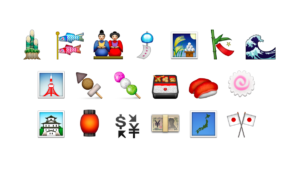Emojis and emoticons: From Japan to the World
Last Monday afternoon, Flavia Milesi, internationalization strategy consultant and export specialist for Japan and South Korea, was invited to give an online lecture on Japanese culture to the students of the course Building Bridges: developing skills to work with people from different cultures, which our CEO Viviana Premazzi is currently teaching at the University of Malta. Below, you can read an adapted version of what she wrote on her LinkedIn the following day.
Yesterday afternoon, I was co-teaching as a guest lecturer with Saverio Aprile at the University of Malta. Saverio’s focus was on digital communication and instant messaging. I had a past episode linked to emojis – which are not exactly the same as emoticons – coming to my mind.
A funny misunderstanding
Years ago, I had asked a favour to a friend who replied to me with the illustration of a woman with her hands crossed across her chest. I understood the meaning of the illustration, that is ダメです! (damedesu), “Absolutely not!” She had meant to… send me a hug.
The day after, a phone call cleared the misunderstanding.

“Emoji” is a Japanese word that we’ve been using on a daily basis since 1999. In that year Mr Shigetaka Kurita – who worked for NTT DoCoMo, a Japanese communication company – gifted his 172 “characters of images” to humanity. “Characters of images” is the literal translation of 絵文字 (emoji).
As such, emotions have actually little to do with the word this word. Although I’d be tempted to write it as エモ字 (emoji) instead, so that we can preserve emotions too 😉
Then, came the time when the mobile telecommunications company SoftBank asked Apple to add emojis to the Japanese text messages on Apple iOS. That’s why many of the “illustrations” that we use today to express our emotions or situations come from Japanese tradition. They are often misinterpreted or misunderstood.
Emoticons
Emoticons, on the other hand, are not illustrations but typographic representations of a face using punctuation and they form part of the text itself.
In this case, the word “emoticon” is a combination of “emotion” + “icon”. Born in 1988, emoticons are much older than emojis.
All this to say that in Japan, although Whatsapp comes with emojis that are culturally comprehensible to everyone, it isn’t widely used. In fact, Japanese people prefer the Korean app LINE. Many of them are still convinced that the app is actually “Made in Japan”… 😛
And so the misunderstandings continue 🙂
To conclude, communicating in the age of communication – and especially digital communication – is neither easy nor a given. And as Saverio said, overusing emojis and emoticons in your digital communication is not always helpful. :-O

Translation from Italian to English by Lucrezia Baldo, GMD communication intern.


